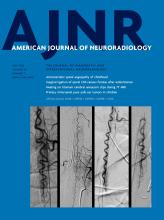The American Society of Neuroradiology (ASNR) Vessel Wall Imaging (MR-VWI) Study Group and all the ASNR members that took the time to respond to their questions should be applauded for this MR-VWI survey. The survey is a comprehensive assessment of the use and perceived value of MR-VWI and was sent to all ASNR members via e-mail. Although the response rate was low at 9% of those surveyed and therefore unlikely to be truly representative of the community, the responses obtained perfectly illustrate many of the important issues involved in the implementation and adoption of new technologies and imaging techniques.
Adoption of intracranial MR-VWI by clinical neuroradiologists has been slow since suppression of luminal flow signal to evaluate the vessel wall was first described in the mid-1990s. Incremental improvements in MR imaging hardware, particularly the increased use of head coils containing more channels, along with refinement of MR imaging sequences, has resulted in superior images and shorter imaging times than were possible previously, making the technique more suitable for clinical use. Imaging times were not addressed by the survey but are still relatively long for clinical use. Most pre- and postcontrast 3D T1 sequences take between 5 and 7 minutes each at 3T, with imaging times longer at up to 9 minutes for each sequence using a 16-channel head coil at 1.5T. Hopefully effort directed at further technique refinement will result in a decrease in these imaging times, allowing greater patient throughput and a decreased number of scans affected by motion artifacts. Decreased scan time and superior 3D image resolution at 3T are likely the reason most respondents are using 3T or a combination of 3T and 1.5T MR imaging for MR-VWI, with only 3 respondents having access to 7T imaging.
The ASNR MR-VWI Study Group has previously published consensus recommendations for current clinical practice in the American Journal of Neuroradiology, using evidence from research studies. From the results of this survey, it seems as though the recommendations of the group have been widely adopted, with 61% of respondents using MR-VWI, basing protocols on published literature, conference lectures, and/or guidance from the ASNR MR-VWI Study Group.
Responses also suggest that MR-VWI has been successfully adopted across different types of practices with use rates only slightly higher in the academic (62%) compared with private practice (52%) settings. Results suggest that the survey responders may be biased toward those most likely to practice subspeciality neurovascular radiology at the highest level. This statement is supported by the high number (42%) of respondents who indicated that their institution had a research agreement with a vendor, with an even higher number (59%) having the expertise to develop their MR-VWI protocol in-house.
Vendor support is very important for optimizing imaging techniques across different imaging platforms in all types of clinical settings, especially when there is no local MR-VWI protocol expertise. The results of the survey suggest that vendors could do more to support neuroradiologists with MR-VWI, with relatively few (39%) of those performing MR-VWI obtaining their protocol from their vendors and 38% indicating limited contributions from vendors in the development of their clinical protocols. I was somewhat surprised that only 31% of those with a vendor research agreement sought support from their vendors for MR-VWI protocol development, given the widespread availability of support for such endeavors, possibly due to these centers already having in-house experts.
When provided, support was higher from Siemens than from the other vendors at 49%. Improved vendor support should be encouraged and should result in more widespread adoption of MR-VWI. Of those not performing MR-VWI, 46% stated that this was due to lack of vendor or technical support for protocol development. Even when vendor support was available, there was certainly room for improvement, with 28% indicating initial difficulties working with their vendors with an eventual solution reached and 23% still looking for a collaborative solution with their vendors. This vendor issue appears to be a wasted opportunity for all concerned, particularly at a time when standardized vendor-neutral protocols and collection and analysis of large, standardized data sets are of increasing importance for population-based research and development of artificial intelligence.
More widespread education of our clinical colleagues is going to be important in ensuring increased patient access to MR-VWI so that they can benefit from the additional information obtained. Of the 48% of responders not performing MR-VWI, 57% indicated that the reason is a lack of ordering-provider interest. The authors of the study have some very sensible suggestions as to how this should be improved, and we should all try to implement their suggestions.
Currently MR-VWI is performed most often as an addition to an MR imaging stroke protocol, with the most common indications being differentiation of vasculopathy, aneurysm characterization, and cryptogenic stroke. Research studies have also shown MR-VWI to be a useful technique for diagnosis, and this is supported by clinical experience, with 41% of responders stating that MR-VWI has had a positive impact on patient care at their institution. Effort should, therefore, be made by the ASNR MR-VWI Study Group and others to increase exposure of neuroradiologists to the technique so that we may all become experts at reading these often-complex studies. More widespread familiarity with MR-VWI, including the pitfalls in image interpretation, will lead to improved patient care, more widespread adoption of MR-VWI, and, hopefully, increased research output related to this useful technique.
- © 2022 by American Journal of Neuroradiology












